Where Do Cashews Come From?
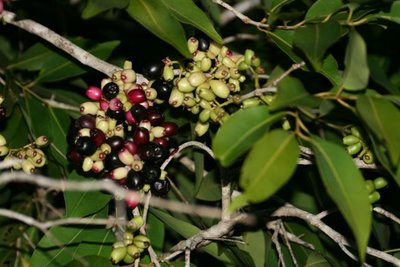 I think I would make a very good toucan, since fruits are my favorite food. Tropical fruits, so much the better. One of the great joys of traveling the Neotropics is eating new and exotic fruits. I am kicking myself for not being able to remember the name of this fruit. It grew on a large, round shrub near Rockview Lodge, and when I squished the soft, grape-sized fruits, the most extraordinary violet juice ran out. It was exactly the color of my Quinacrodone Violet watercolor. Eaten, it tasted like a cross between grape and aftershave. It was extraordinary, and I gobbled a bunch of them down before it occurred to me that I might want to play it cool, not knowing what medicinal properties such an exotic-tasting fruit might possess.
I think I would make a very good toucan, since fruits are my favorite food. Tropical fruits, so much the better. One of the great joys of traveling the Neotropics is eating new and exotic fruits. I am kicking myself for not being able to remember the name of this fruit. It grew on a large, round shrub near Rockview Lodge, and when I squished the soft, grape-sized fruits, the most extraordinary violet juice ran out. It was exactly the color of my Quinacrodone Violet watercolor. Eaten, it tasted like a cross between grape and aftershave. It was extraordinary, and I gobbled a bunch of them down before it occurred to me that I might want to play it cool, not knowing what medicinal properties such an exotic-tasting fruit might possess.The pattern this plant shows is one typical of many tropical fruits--a cluster of many fruits, some dead ripe, some ripening, some not even close to ripe. This is a way for the plant to prolong the visitation by seed dispersers, to have them build it into their foraging routes. There may be only a few dead ripe, but there will be more tomorrow, and more a month from now. The fruit colors signal clearly when they're ready to be eaten. Blue fruits generally are most attractive to birds. White means don't eat this yet!
I learned to love starfruit, or carambola, while living in Brazil for six months.
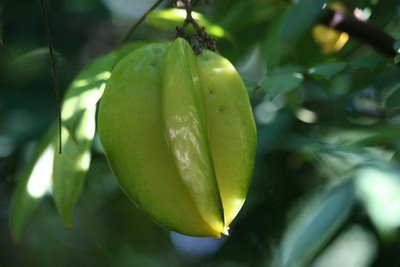 I'd never seen the flower, though. What a charming little pink flower!
I'd never seen the flower, though. What a charming little pink flower!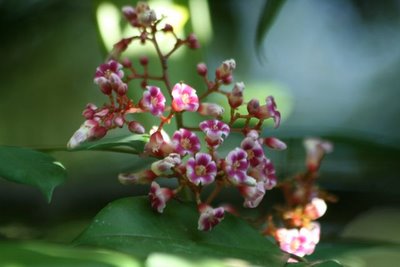
Here's a papaya tree in full fruit. Yikes. Imagine putting out that much fruit!
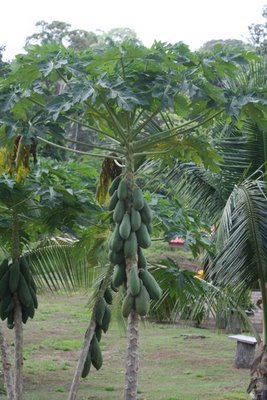 Each one is almost a foot long. The common name in Brazil is mamao, which means "big tit."
Each one is almost a foot long. The common name in Brazil is mamao, which means "big tit."Passionflowers, yet to open. Passionfruit is amazing--just a cluster of seeds surrounded by the most heavenly tasting slime. And boy does it make you dream!
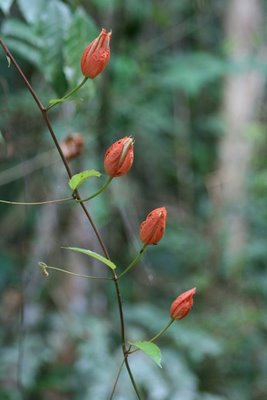
A pineapple in flower. You can really see its affinity to bromeliads when it flowers.
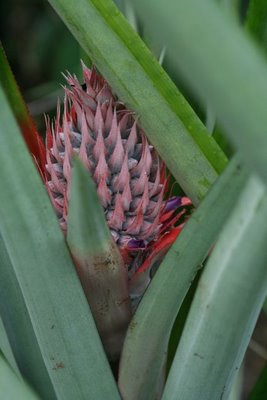 Hummingbirds visit the little purple flowers coming out of the bracts, which will soon be the spines on a pineapple fruit.
Hummingbirds visit the little purple flowers coming out of the bracts, which will soon be the spines on a pineapple fruit.All through the trip, I tried to photograph the various life stages of the cashew wherever I found a tree. I'm fascinated by this plant, and I love the nuts and fruits. Most people don't know how cashews grow, so I wanted to share these photos.
The cashew , Anacardium occidentale, is an evergreen tree with large, leathery, fiddle-shaped leaves and a spreading crown. Here are the leaves and flowers.
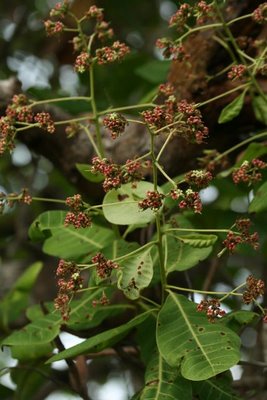 It is in the same family as poison ivy (Anacardiaceae). Right there, you know that you don't want to mess with it. I had a steep learning curve upon first arriving in the Amazon.
It is in the same family as poison ivy (Anacardiaceae). Right there, you know that you don't want to mess with it. I had a steep learning curve upon first arriving in the Amazon.The fruit of the cashew is two-parted. Here are some in early development.
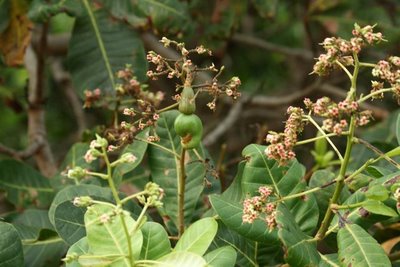 You can see the classic kidney-shaped green seed forming--that's the cashew "nut," though it's not technically a tree nut--it's just a seed. But there's a second part atop that, and that's called the cashew "apple." It's not technically a fruit, either; it's more a swollen, sweet tasting, incredible delicious peduncle. Botanists would call it a false fruit, since it's really more like a stem. Here are a bunch of them hanging, and there's a green cashew seed attached to the bottom of each one.
You can see the classic kidney-shaped green seed forming--that's the cashew "nut," though it's not technically a tree nut--it's just a seed. But there's a second part atop that, and that's called the cashew "apple." It's not technically a fruit, either; it's more a swollen, sweet tasting, incredible delicious peduncle. Botanists would call it a false fruit, since it's really more like a stem. Here are a bunch of them hanging, and there's a green cashew seed attached to the bottom of each one.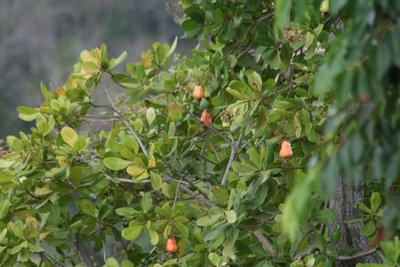 When the cashew apple is ripe, it turns the most wonderful yellow, then orange, and finally a pinky-red.
When the cashew apple is ripe, it turns the most wonderful yellow, then orange, and finally a pinky-red.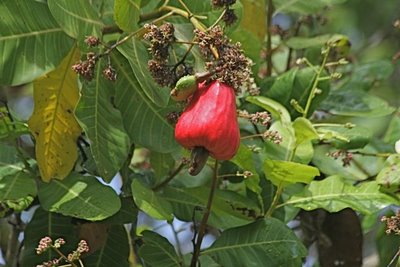
Back to the warning: If you're going to eat a cashew apple, you have to twist the seed off and throw that away. The apple is delicious--extremely juicy, with dense yellow flesh; sweet, and so thin-skinned that it barely survives picking, much less shipping (which is why you've probably never seen it!) The juice runs down your chin and you have to bend over to eat it. Some people are allergic to it, though, and it can make your face break out in a rash if you are. Luckily, I'm not.
The seed's green casing has a resin called urushiol in it, which is the same compound that causes the horrid rash from poison ivy. And the raw seed can produce potentially fatal reactions in people who are sensitive to urushiol (that would be me). So before a cashew seed can be eaten, it has to be roasted (often over an open fire). The green shell is peeled off by hand, and the seeds are then blanched, usually by steaming. There are not many things that we eat that are deadly poisonous before they're cooked, but I understand that it is illegal to export raw cashews, because people could die from eating them--they must be blanched before export. So the "raw" cashews you see in health food stores have had the urushiol-laden green shells removed, and have then been steamed, and are safe to eat.
I can only marvel at the ingenuity of the first indigenous Brazilians to figure out how to make such a deadly but delicious seed safe to eat. One supposes there was trial and error involved. Just for fun: Other plants in the Anacardiaceae include pistachios and mangoes (O heavenly fruit!) Oh, and sumac, and poison ivy...some family, huh?
Labels: carambola, cashew flowers, cashew fruit, cashew nuts, pineapple, starfruit, starfruit flowers





